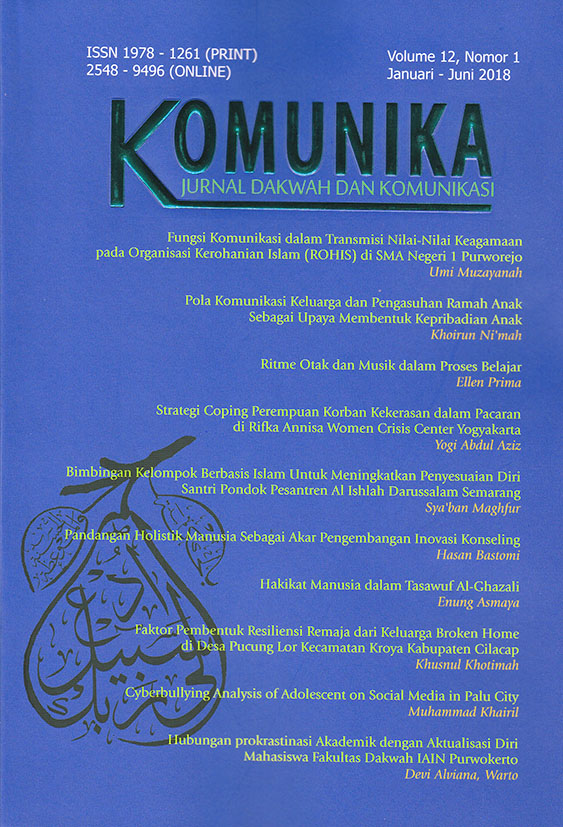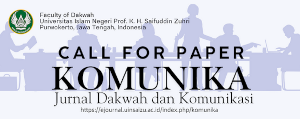Understanding The Perpetrators And Victims of Cyberbullying Through Facebook in The City of Palu
DOI:
https://doi.org/10.24090/komunika.v12i1.1646Keywords:
Cyberbullying, Social Media, Internet, InteractionAbstract
Communication Technology is growing rapidly, it reflects the social behavior of people in this digital era. Harassment is common in real world, thus it is also often in virtual life which leads to cyber harassment or cyberbullying. This research focuses on the Facebook users in reaction to the electing stimulus they got. The behavior of cyberbullying communication is an adverse behavior not only for the object (victim) but also the subject (actor) of cyberbullying itself. The purpose of this research is to identify the respondent behavior and as operant behavior. This research utilize a descriptive-qualitative approach using case study method. The electing stimulations found in the form of online (online interaction through Facebook) or offline (based on real world interaction, not via Facebook) stimuli. Based on the observation and interview with respondent, it can be concluded that there are three forms of cyberbullying communication behavior by youngadults in Palu City that occurred on Facebook, namely impersonation, denunciation, and flame war.Downloads
Download data is not yet available.
References
Aini. (2012). Penelitian Menggunakan Teori Pembelajaran Sosial Bandura. Retrieved January 1, 2015, from http://staff.uny.ac.id/sites/default/files/penelitian/Aini Mahabbati, S.Pd., M.A./bandura0002.pdf
Al-Rahmi, W. M., & Zeki, A. M. (2017). A model of using social media for collaborative learning to enhance learners’ performance on learning. Journal of King Saud University - Computer and Information Sciences , 29 (4), 526–535. https://doi.org/10.1016/j.jksuci.2016.09.002
Al-Rahmi, W., Othman, M., & Musa, M. (2014). THe Improement of Students’ Academic Performance by Using Social Media Through Collaborative learning in Malaysian Higher Education. Asian Soc. Sci., 10(8), 210–221.
Budiargo, D. (2015). Berkomunikasi Ala Net Generation . Jakarta: PT. Gramedia.
Bungin, B. (2014). Sosiologi Komunikasi: Teori, Paradigma, dan Diskursus Teknologi Komunikasi di Masyarakat. Jakarta: Kencana.
Donegan, R. (2012). Bullying and Cyberbullying: History, Statistics, Law, Prevention and Analysis. Elon J Undergraduate Res Commun., 3(1), 33–42. Retrieved from https://www.google.com/urlsa=t&rct=j&q=&esrc=s&source=web&cd=1&cad=rja&uact=8&ved=0ahU KEwj2kd3NzcLXAhWKu7wKHTn0CPEQFggpMAA&url= https%3A%2F%2F www.elon.edu%2Fdocs%2Fe-web%2Facademics%2Fcommunications%2Fresearch%2Fvol3no1%2F04 doneganejspring12.pdf&usg=AOvVa
Hambali, A., & U., J. (2013). Psikologi Kepribadian Lanjutan (Studi atas Teori dan Tokoh Psikologi Kepribadian. Bandung: CV. Pustaka Setia.
Hemphill, S. A., & Heerde, J. A. (2014). Adolescent Predictors of Young Adult Cyberbullying Perpetration and Victimization Among
Australian Youth. Journal of Adolescent Health, 55(4), 580–587. https://doi.org/10.1016/j.jadohealth.2014.04.014
Jaenudin, U. (2015). Teori-Teori Kepribadian. Bandung: CV. Pustaka Setia.
Kowalski, R. M., & Limber, S. P. (2013). Psychological, Physical, and Academic Correlates of Cyberbullying and Traditional Bullying.
Journal of Adolescent Health, 53(1), 13–20. https://doi.org/10.1016/j.jadohealth.2012.09.018
Kurt, H. (2015). Acritical Review to the Media which Constructed in Media Literary Course in Secondary Education. Procedia-Social and Behavioral Sciences , 174 , 711–719. https://doi.org/10.1016/j.sbspro.2015.01.606
Margono, H., Yi, X., & Raikundalia, G. K. (2014). Mining Indonesian Cyber Bullying Patterns in Social Networks. In Proceedings of theThirty-Seventh Australasian Computer Science Conference (pp. 115–124). Auckland, New Zealand: College of Engineering and Science Victoria University. Retrieved from http://crpit.com/confpapers/CRPITV147Margono.pdf
Morissan. (2014). Teori Komunikasi: Individu hingga Massa. Jakarta: Kencana.
Nasrullah, R. (2016). Media Sosial: Perspektif Komunikasi, Budaya, dan Sosioteknologi. Bandung: Simbiosa Rekatama Media.
Ndiayea, I. A., & Ndiayea, B. (2014). Sociocultural Stereotypes in Media and Intercultural Communication (Africa in the Polish Media). Procedia - Social and Behavioral Sciences, 154(October), 72–76. https://doi.org/10.1016/j.sbspro.2014.10.114
Nicolas Alarcón, C., Urrutia Sepúlveda, A., Valenzuela-Fernández, L., & Gil-Lafuente, J. (2018). Systematic mapping on social media and its relation to business. European Research on Management and Business Economics , 24 (2), 104–113. https://doi.org/10.1016/j.iedeen.2018.01.002
Notar, C. E., Padgett, S., & Roden, J. (2013). Cyberbullying: A Review of the Literature. Universal Journal of Educational Research, 1(1), 1–9. https://doi.org/10.13189/ujer.2013.010101
Rudi. (2010). Informasi Perihal Bullying: Tindakan Cyber Bullying. Jakarta: Rajawali Press.
Sarwono, S. W. (2002). Psikologi Sosial. Jakarta: Balai Pustaka.
Suranto, A. W. (2011). Komunikasi Interpersonal. Yogyakarta: Graha Ilmu.
Thurlow, C., & et. al. (2005). Computer Mediated Communication. London: Sage Publication.
Waasdorp, T. E., & Bradshaw, C. P. (2015). The Overlap Between Cyberbullying and Traditional Bullying. Journal of Adolescent Health , 56 (5), 483–488. https://doi.org/10.1016/j.jadohealth.2014.12.002
Al-Rahmi, W. M., & Zeki, A. M. (2017). A model of using social media for collaborative learning to enhance learners’ performance on learning. Journal of King Saud University - Computer and Information Sciences , 29 (4), 526–535. https://doi.org/10.1016/j.jksuci.2016.09.002
Al-Rahmi, W., Othman, M., & Musa, M. (2014). THe Improement of Students’ Academic Performance by Using Social Media Through Collaborative learning in Malaysian Higher Education. Asian Soc. Sci., 10(8), 210–221.
Budiargo, D. (2015). Berkomunikasi Ala Net Generation . Jakarta: PT. Gramedia.
Bungin, B. (2014). Sosiologi Komunikasi: Teori, Paradigma, dan Diskursus Teknologi Komunikasi di Masyarakat. Jakarta: Kencana.
Donegan, R. (2012). Bullying and Cyberbullying: History, Statistics, Law, Prevention and Analysis. Elon J Undergraduate Res Commun., 3(1), 33–42. Retrieved from https://www.google.com/urlsa=t&rct=j&q=&esrc=s&source=web&cd=1&cad=rja&uact=8&ved=0ahU KEwj2kd3NzcLXAhWKu7wKHTn0CPEQFggpMAA&url= https%3A%2F%2F www.elon.edu%2Fdocs%2Fe-web%2Facademics%2Fcommunications%2Fresearch%2Fvol3no1%2F04 doneganejspring12.pdf&usg=AOvVa
Hambali, A., & U., J. (2013). Psikologi Kepribadian Lanjutan (Studi atas Teori dan Tokoh Psikologi Kepribadian. Bandung: CV. Pustaka Setia.
Hemphill, S. A., & Heerde, J. A. (2014). Adolescent Predictors of Young Adult Cyberbullying Perpetration and Victimization Among
Australian Youth. Journal of Adolescent Health, 55(4), 580–587. https://doi.org/10.1016/j.jadohealth.2014.04.014
Jaenudin, U. (2015). Teori-Teori Kepribadian. Bandung: CV. Pustaka Setia.
Kowalski, R. M., & Limber, S. P. (2013). Psychological, Physical, and Academic Correlates of Cyberbullying and Traditional Bullying.
Journal of Adolescent Health, 53(1), 13–20. https://doi.org/10.1016/j.jadohealth.2012.09.018
Kurt, H. (2015). Acritical Review to the Media which Constructed in Media Literary Course in Secondary Education. Procedia-Social and Behavioral Sciences , 174 , 711–719. https://doi.org/10.1016/j.sbspro.2015.01.606
Margono, H., Yi, X., & Raikundalia, G. K. (2014). Mining Indonesian Cyber Bullying Patterns in Social Networks. In Proceedings of theThirty-Seventh Australasian Computer Science Conference (pp. 115–124). Auckland, New Zealand: College of Engineering and Science Victoria University. Retrieved from http://crpit.com/confpapers/CRPITV147Margono.pdf
Morissan. (2014). Teori Komunikasi: Individu hingga Massa. Jakarta: Kencana.
Nasrullah, R. (2016). Media Sosial: Perspektif Komunikasi, Budaya, dan Sosioteknologi. Bandung: Simbiosa Rekatama Media.
Ndiayea, I. A., & Ndiayea, B. (2014). Sociocultural Stereotypes in Media and Intercultural Communication (Africa in the Polish Media). Procedia - Social and Behavioral Sciences, 154(October), 72–76. https://doi.org/10.1016/j.sbspro.2014.10.114
Nicolas Alarcón, C., Urrutia Sepúlveda, A., Valenzuela-Fernández, L., & Gil-Lafuente, J. (2018). Systematic mapping on social media and its relation to business. European Research on Management and Business Economics , 24 (2), 104–113. https://doi.org/10.1016/j.iedeen.2018.01.002
Notar, C. E., Padgett, S., & Roden, J. (2013). Cyberbullying: A Review of the Literature. Universal Journal of Educational Research, 1(1), 1–9. https://doi.org/10.13189/ujer.2013.010101
Rudi. (2010). Informasi Perihal Bullying: Tindakan Cyber Bullying. Jakarta: Rajawali Press.
Sarwono, S. W. (2002). Psikologi Sosial. Jakarta: Balai Pustaka.
Suranto, A. W. (2011). Komunikasi Interpersonal. Yogyakarta: Graha Ilmu.
Thurlow, C., & et. al. (2005). Computer Mediated Communication. London: Sage Publication.
Waasdorp, T. E., & Bradshaw, C. P. (2015). The Overlap Between Cyberbullying and Traditional Bullying. Journal of Adolescent Health , 56 (5), 483–488. https://doi.org/10.1016/j.jadohealth.2014.12.002
Downloads
Published
2018-06-30
Issue
Section
Articles
License
Authors who publish with this journal agree to the following terms:
- Authors retain copyright and grant the journal right of first publication with the work simultaneously licensed under a Creative Commons Attribution-ShareAlike 4.0 International License that allows others to share the work with an acknowledgement of the work's authorship and initial publication in this journal.
- Authors are able to enter into separate, additional contractual arrangements for the non-exclusive distribution of the journal's published version of the work (e.g., post it to an institutional repository or publish it in a book), with an acknowledgement of its initial publication in this journal.
- Authors are permitted and encouraged to post their work online (e.g., in institutional repositories or on their website) prior to and during the submission process, as it can lead to productive exchanges, as well as earlier and greater citation of published work (See The Effect of Open Access).

























